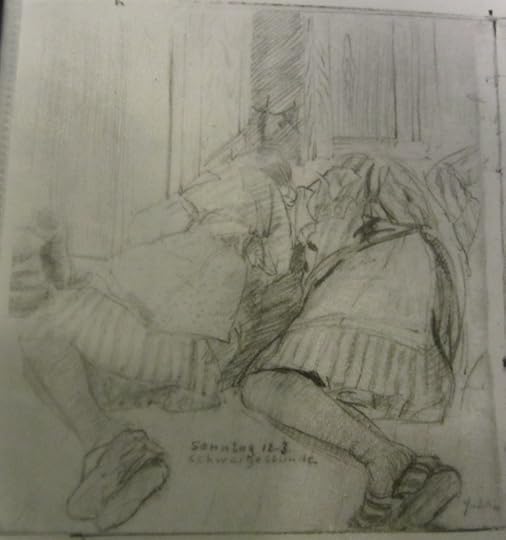One more from Ravensbrück

location of Block 32. Check out the Soviet graffiti.
One of the conference members turns up this morning with a sticking plaster across the bridge of his nose.
Sheepishly: ‘A door attacked me. I don’t even know if it was an anti-Semitic door.’
Me: ‘It is probably just doing its job as a door.’
------------------
This conference would have been impossible for me without the assistance of a pair of talented translators who have basically repeated absolutely everything spoken aloud in plenary sessions and workshops for the past four days, mostly in English for me, but occasionally in German (from English) for the small handful of European participants who aren’t actually fluent in English. OMG it makes me feel so dumb. But I’m also hugely grateful and impressed at how hard these guys work and how talented they are. I walk around with a little box the size of a carton of cigarettes which hangs around my neck, with my earbuds plugged in — you have to rip them out immediately if you want to say something or if someone else starts speaking English, because the translation suddenly switches instantly into German and then you forget what you were going to say because your words are being turned into German in your ear.
Pretty amazing technology combined with amazing people. (When I close my eyes, as I fall asleep, I hear ‘German’ being spoken in my head. Of course it is not really German. But I still hear it.)
I thought I’d also comment on the exhibit in the cell block here, which is nifty. So what do you do with several dozen tiny empty rooms fraught with suffering? They have given each different nation who had women imprisoned here a separate room in which to construct an individual national memorial. The result is wildly varied and often reflects national character and ethnicity. The displays suffer because as museum exhibits they’re getting a bit tatty; unfortunately or fortunately, because they’re governed by the rules for memorials, they can’t be altered in any way. Despite this it’s a really great use of the space. The memorials are all on the upper floor of the cell block, which is oriented around a central well, so the space that unifies the exhibit is light and airy. Below, on the sub-ground level, are more conventional prison cells.
It’s pretty creepy down there, but it makes an appropriate sobering contrast to the exuberance and intensity of the national memorial exhibits upstairs.
---------------------------------

drawing by Aat Breur, 1943
I'm pretty sure this is the same scene as the one below. The trees in the foreground are probably the actual same trees (many of the trees on site were planted during the time the camp was in operation). The building in the picture below was originally outside the camp walls - the wall there, and the barracks you can see in the drawings, are gone now. The tall pine trees on the bank behind the wall are also gone, and apparently this is something that former prisoners remark on when they come back - they miss the trees. The trees were all they could see of outside.

2012
I am a fan of Aat Breur's drawings, though I have previously only seen portraits she's made which are reprinted in various books. I love these pictures of sleeping women (they look to me like they are sleeping, not dead. The second one is titled 'Silent Hour.')


--------------------
After I hauled about a dozen books on Ravensbrück and the Nuremberg trials with me to Pennsylvania and back this summer without opening any of them, Tim asked me as I was packing for this trip: ‘How many books that you don’t read are you going to take with you this time?’ The answer is four. Yup, I didn’t read a single book I brought with me. I go home tomorrow.
Published on August 30, 2012 13:28
No comments have been added yet.



